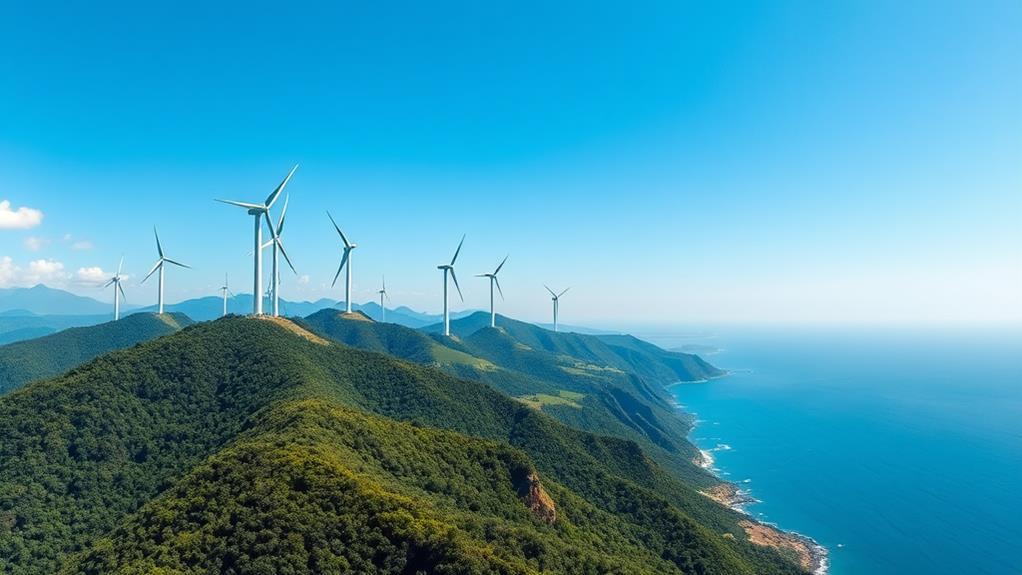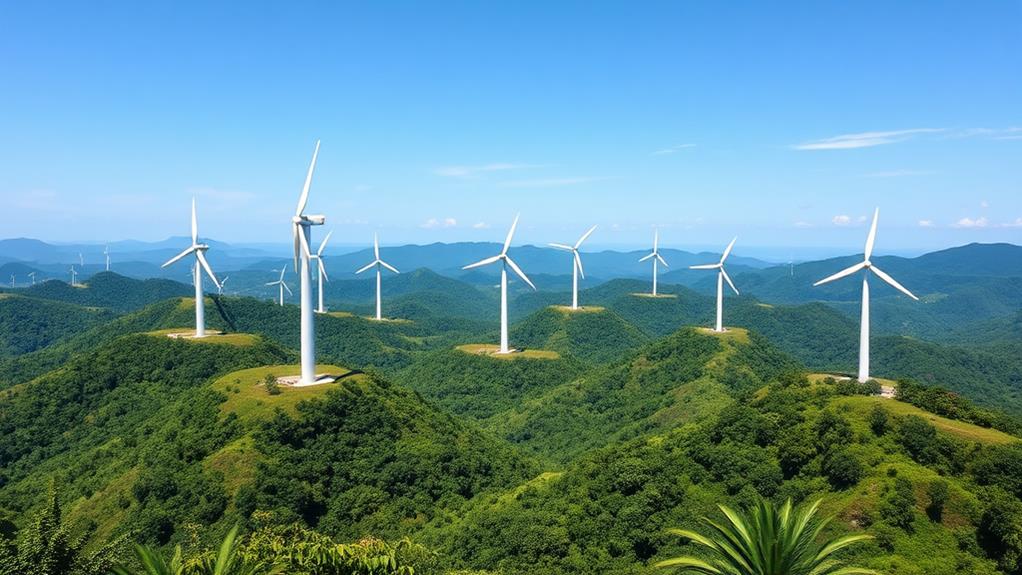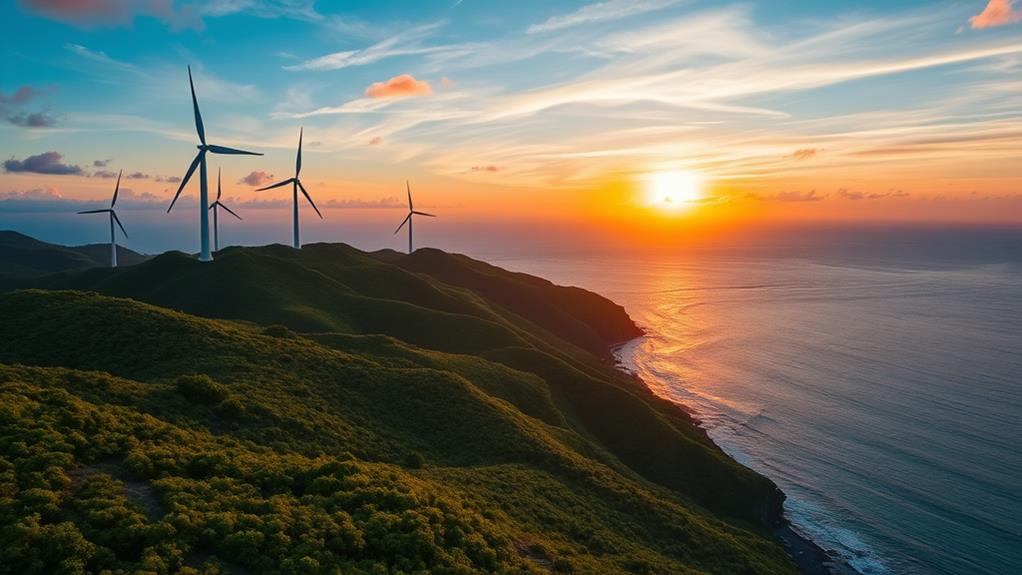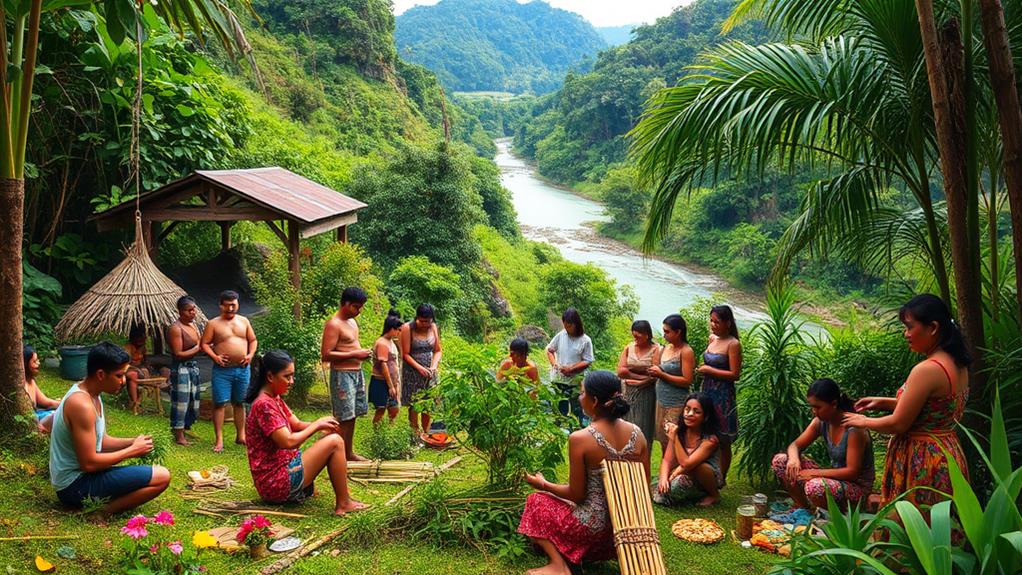To harness the power of nature for sustainable development in the Philippines, focus on wind energy and nature-based solutions. Wind energy is a clean and renewable source of power that can provide a significant portion of the country’s electricity needs. By investing in wind farms and other wind power infrastructure, the Philippines can reduce its reliance on fossil fuels and decrease its carbon footprint. In addition, incorporating nature-based solutions, such as reforestation and sustainable land management, can help protect the environment while promoting economic growth. Traditional ecological knowledge, passed down through generations, can also play a crucial role in guiding sustainable development practices that are both effective and culturally sensitive.
The Philippines has strong wind resources, particularly in areas like Ilocos Norte, which offers great potential for clean energy. For example, the Burgos Wind Farm is a current project demonstrating this potential.
Community engagement is crucial in these efforts. By restoring wetlands, we can improve biodiversity and help fight climate change.
Addressing challenges, such as the need for initial investment, can lead to significant opportunities for progress.
These strategies can lead to effective and sustainable development in the Philippines.
Geographic Advantages for Wind Energy

The Philippines has strong advantages for wind energy due to its geography.
It is located in the western Pacific, which allows it to benefit from powerful and steady winds.
The country's mountainous regions, like Luzon and Mindanao, create wind patterns that boost energy production.
Currently, the Philippines has 443 MW of installed capacity from onshore wind farms.
The Burgos Wind Farm is the largest, with a capacity of 150 MW.
The government aims to increase this capacity to 5 GW by 2030, showing a commitment to growth and investment in wind energy.
The waters surrounding the Philippines also offer opportunities for wind energy projects, both onshore and offshore.
By using these geographic strengths, the Philippines can improve its renewable energy sources, making its energy supply stronger and more sustainable.
Maximizing wind energy is essential for the country's long-term sustainability.
Current Wind Energy Projects
The Philippines is making significant progress in wind energy projects. The country has a total installed capacity of 443 MW in wind power. The largest project is the Burgos Wind Farm, which has a capacity of 150 MW and is located in Ilocos Norte.
Other important projects include the Caparispisan Wind Farm at 81 MW and the Pililla Wind Farm at 54 MW. These projects not only provide renewable energy but also create jobs and generate tax revenue for local communities.
The Philippine government plans to increase its onshore wind power capacity to 5 GW by 2030. This shows a strong potential for growth in the wind energy sector.
Wind energy is a clean power source that helps improve energy security and reduces greenhouse gas emissions. Experts predict that there will be an increase in wind energy capacity by 2025, driven by better technology and new offshore wind projects.
These wind energy initiatives are crucial for the Philippines' energy future, promoting economic growth while tackling environmental issues.
Benefits of Wind Energy

Wind energy has many benefits beyond just making electricity. It is a clean and renewable energy source, which means it helps to lower greenhouse gas emissions. This is important for fighting climate change.
For example, the Philippines currently has 443 MW of wind power capacity from onshore wind farms, like the Burgos Wind Farm, showing there's a lot of room for growth.
The government aims for 5 GW of installed onshore wind power by 2030. This shows a strong commitment to increasing wind energy. Investing in local wind resources not only creates a reliable energy system but also generates job opportunities.
Wind farms help local economies by providing tax revenue, which allows communities to flourish.
Looking ahead, the expected growth in wind energy capacity by 2025 is promising. This growth is driven by more investments in offshore projects and new technology.
Challenges to Wind Energy Adoption
Wind energy has many benefits for the Philippines, but several challenges make it hard to adopt widely. High initial capital investment is a major issue that discourages investors. For example, building wind farms requires a lot of money upfront, which can slow down their development.
Land acquisition issues also complicate things. Finding and securing land for wind farms can delay projects, making it harder to set up the needed infrastructure.
Another challenge is the intermittent nature of wind energy. Wind conditions can change, leading to fluctuations in energy generation. This inconsistency raises concerns about reliability and can affect grid stability. Limited grid infrastructure makes it difficult to transmit energy from remote wind farms to where it is needed.
Lastly, regulatory hurdles can slow down the approval process for new projects. Long bureaucratic procedures make it harder to expand wind energy capacity.
| Challenge | Impact on Wind Energy | Possible Solution |
|---|---|---|
| High Initial Investment | Deterrent for investors | Incentives and funding |
| Land Acquisition Issues | Delays in project setup | Streamlined processes |
| Intermittent Energy Supply | Reliability concerns | Energy storage solutions |
Addressing these challenges is crucial for moving to a more sustainable energy source and reducing reliance on fossil fuels.
Future Developments in Wind Energy

The Philippines is planning to increase its onshore wind power capacity to 5 GW by 2030. This goal will be supported by projects like the expansion of the Ilocos Norte Wind Farm and the Bangui Windmills, which will help generate more energy.
Currently, the country's installed capacity is 443 MW, with the Burgos Wind Farm being the largest at 150 MW.
There is also a growing focus on offshore wind projects due to the country's ideal weather conditions. By using geographic information systems to gather data, developers can find the best locations for new wind farms. This method makes the planning process more efficient and helps increase renewable energy sources.
Technological advancements are improving wind energy systems, which attracts more investment. As these projects begin, they're expected to have a positive economic impact by creating jobs and boosting local economies.
Nature-Based Solutions Overview
Nature-Based Solutions (NbS) are effective strategies that use natural processes to solve important social problems. These solutions benefit both human well-being and biodiversity. For example, wetland restoration and tree planting help protect wildlife while also addressing climate change.
To use NbS successfully, it's crucial to have clear definitions and frameworks that fit with current development policies. Community engagement is essential. Involving local people ensures that conservation efforts meet the needs of Indigenous Peoples. Their knowledge is valuable for making NbS work better.
Collaboration among different sectors is also important. By uniting government, non-government organizations, and private companies, we can create a strong approach that enhances the impact of NbS.
This teamwork helps communities make choices that support both ecological health and economic stability. In summary, NbS is a key way to achieve sustainable development, making it important to adopt these practices for a better future in the Philippines.
How Can Conservation of Landforms and Water Bodies Support Sustainable Development in the Philippines?
The conservation of landforms and water bodies can bolster sustainable development by preserving ecosystems essential for livelihoods, agriculture, and tourism. By safeguarding philippine landforms sustainable future initiatives thrive, fostering biodiversity, reducing risks of natural disasters, and ensuring resources for generations. Responsible stewardship guarantees a balance between progress and environmental preservation.
Community Empowerment Strategies

Community empowerment strategies are essential for sustainable development in the Philippines. Debt-for-nature swap financing allows local communities to manage and protect forest ecosystems. This method respects community rights and encourages active participation in conservation.
The Forest Foundation focuses on the rights of Indigenous Peoples by involving them in decision-making. This is important for successful forest management and protecting biodiversity.
For example, the B+WISER initiative has trained 670 forest patrollers, mainly from Indigenous groups, highlighting the importance of local knowledge for climate resilience.
Additionally, community-based tourism supports local engagement and promotes regenerative practices. These practices not only help conservation but also create economic opportunities for residents.
By bringing together local communities, universities, and local government, a collaborative approach is formed. This teamwork boosts the sustainability and success of nature-based solutions.
Questions and Answers
What Are the Strategies to Achieve Sustainable Development in the Philippines?
To achieve sustainable development in the Philippines, it is essential to engage local communities. Community involvement helps ensure that development projects meet the needs of the people. For example, when locals are part of decision-making, they can suggest solutions that work best for their areas.
Implementing strong policy frameworks is also important. This means creating rules and guidelines that support sustainable practices. For instance, laws that promote recycling and waste management can help reduce pollution.
Promoting renewable technologies plays a crucial role in sustainability. Using solar panels or wind turbines can provide clean energy. For example, solar energy can power homes and schools, reducing reliance on fossil fuels.
Enhancing ecological conservation is vital for protecting the environment. This includes preserving forests, rivers, and wildlife. For instance, establishing protected areas helps maintain biodiversity and prevents habitat loss.
Lastly, it is necessary to support local livelihoods. This means creating job opportunities that are sustainable and environmentally friendly. For example, promoting eco-tourism can provide income while preserving natural resources.
What Is the Status of Sustainable Development in the Philippines?
Sustainable development in the Philippines focuses on several key areas. Urban resilience strategies help cities prepare for and recover from disasters. For instance, improving infrastructure and emergency response systems can protect communities from floods and earthquakes.
Biodiversity conservation efforts aim to protect the country's rich wildlife and natural resources. An example is the establishment of protected areas like the Tubbataha Reefs Natural Park, which safeguards marine life.
Integrating indigenous practices involves using traditional knowledge for sustainable resource management. For example, indigenous communities often practice sustainable farming techniques that preserve soil health.
Coastal management initiatives work to protect coastal areas from pollution and overfishing. Projects like mangrove reforestation help stabilize shorelines and support marine ecosystems.
Ecological restoration projects focus on reviving damaged environments. For instance, replanting trees in deforested areas helps restore habitats and improve air quality.
These strategies are essential for tackling environmental challenges and supporting the well-being of communities in the Philippines.
What Is the Goal 4 of Sustainable Development in the Philippines?
Goal 4 aims to ensure education equity and inclusive learning in the Philippines. This means providing quality education for everyone, regardless of their background. For example, schools should be accessible to children with disabilities.
Promoting gender parity is also a key part of this goal. This means that boys and girls should have the same opportunities to learn. In many areas, girls may face barriers to education, such as early marriage or cultural expectations.
Addressing disparities is crucial, especially in marginalized communities. For instance, children in rural areas may not have the same access to resources as those in urban settings. By focusing on these areas, the goal is to create a fair education system for all.
What Are the Energy Sources Utilized by Communities in the Philippines How Are They Harnessed?
In the Philippines, communities use renewable energy from sources like wind, solar, and hydropower. For example, wind energy is harnessed by installing wind turbines in areas with strong winds, especially in places like Ilocos Norte. Solar energy is captured through solar panels on rooftops or solar farms, commonly found in provinces like Palawan. Hydropower is generated by building dams and using flowing water, as seen in the rivers of Luzon. By combining these energy sources with energy efficiency practices, communities create sustainable solutions to meet their energy needs.